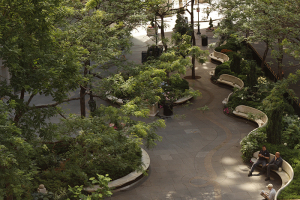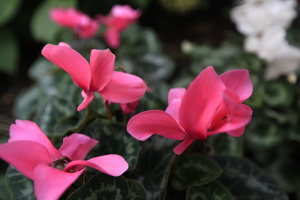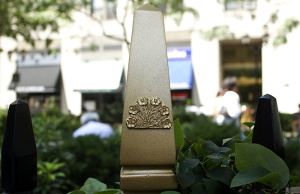By Laura Lenis, Program Coordinator and Social Media Manager at the Queen Elizabeth II Garden
We’re always looking for slices of British culture in American life. Royal Oak is fortunate to host lectures from the UK often, so that we can all enjoy precisely that sort of taste. But outside of the UK, it’s tough to experience the splendor and tranquility of an English garden. However, right in our own backyard, in Lower Manhattan, lies the Queen Elizabeth II Garden. Read guest blogger Laura Lenis, Program Coordinator and Social Media Manager at the Garden, on the significance and beauty of this unique, living monument.

The Queen Elizabeth II Garden on a warm Spring day
Within the shady recesses of New York’s financial district is a garden, commissioned by the British Memorial Garden Trust and given to the City in memory of the British and Commonwealth citizens who lost their lives during the attacks of September 11, 2001 and in the ensuing wars.

The Queen Elizabeth Garden sits within NYC’s Financial District
The garden was developed by English landscape designers Julian and Isabel Bannerman. Shaped as a loose silhouette of the British Isles lain over this historic public square, the garden is encircled by Morayshire sandstone inlay, quarried from the highlands of Scotland. A geography lesson, the sandstone is inscribed with the shires of the British Isles – from Aberdeen to Portland. The large and rounded ‘Braemar’ stone from a riverbed near HM The Queen’s home in Balmoral, sits in the south end of the garden, in the spirit of a cairn, marking the distance from Aberdeen.
The rich tradition of English gardens meets the urban American landscape. New York based garden designers Lynden B. Miller and Ronda M. Brands worked with the Bannerman design to create an enduring garden for all seasons, selecting plants from both the British Isles and the North American landscape that echo the spirit of an English garden. English mixed borders are known for their particular way in which they establish structure with shrubs – often boxwood and yew – and then cultivate seasonal exuberance with perennials, annuals, and bulbs, with an emphasis on year-round sequence of bloom and interest. The Garden strives to honor and maintain this example of excellence.
At the northern end stand two tall Canadian hemlocks (Tsuga canadensis ‘Fastigiata’) which softly frame the inner path of the garden. Running the length of the garden is a ribbon of 67 heavenly bamboo shrubs (Nandina domestica ‘Gulf Stream’), each signifying one of the 67 British victims of September 11th. These finely-etched semi-evergreen shrubs turn red and orange in the colder months. Deep green spires of Sky Pencil hollies (Ilex crenata ‘Sky Pencil’) and Graham Blandy boxwoods (Buxus sempervirens ‘Graham Blandy’) add depth and vertical accents to the garden. Marking the southern entrance are two evergreen holly trees: Ilex x aquipernyi ‘Dragon Lady’ – a cultivar bred from an English holly parent.
Serpentine benches made of white Portland stone quarried in southern England and carved in Northern Ireland run through the garden, with a backdrop of yew shrubs (Taxus x media ‘Brownii’) – long-lived evergreens often found in English churchyards, a natural link between the living and the dead.
 These plants form the backbone of the garden and suggest the narrative that led to its making. Nestled among them are herbaceous and woody flowering plants that are often found in a shady English garden. Yellow daffodils (Narcissus cvs.), pink bleeding heart (Lamprocapnos spectabilis), and the tiny blue flowers of Siberian bugloss (Brunnera macrophylla) bloom in early spring, among rhododendrons and azaleas. Foamflower (Tiarella cordifolia) and summersweet (Clethra alnifolia), plants native to both Canada and the U.S., add flowers and fragrance to the garden. Foxgloves (Digitalis purpurea) and meadowsweet (Spiraea japonica ‘Neon Flash’) and a variety of hydrangeas – bigleaf, oakleaf, variegated, and climbing – flower in midsummer, followed by the nodding pink blossoms of Japanese anemone (Anemone x hybrida ‘Robustissima’). The hardy camellia (Camellia x ‘Long Island Pink’) brightens the early winter landscape.
These plants form the backbone of the garden and suggest the narrative that led to its making. Nestled among them are herbaceous and woody flowering plants that are often found in a shady English garden. Yellow daffodils (Narcissus cvs.), pink bleeding heart (Lamprocapnos spectabilis), and the tiny blue flowers of Siberian bugloss (Brunnera macrophylla) bloom in early spring, among rhododendrons and azaleas. Foamflower (Tiarella cordifolia) and summersweet (Clethra alnifolia), plants native to both Canada and the U.S., add flowers and fragrance to the garden. Foxgloves (Digitalis purpurea) and meadowsweet (Spiraea japonica ‘Neon Flash’) and a variety of hydrangeas – bigleaf, oakleaf, variegated, and climbing – flower in midsummer, followed by the nodding pink blossoms of Japanese anemone (Anemone x hybrida ‘Robustissima’). The hardy camellia (Camellia x ‘Long Island Pink’) brightens the early winter landscape.
At the southern end of the planting beds – where the nandina ribbon ends – rises a yellow magnolia, called Magnolia ‘Elizabeth’. HM Queen Elizabeth II, the garden’s namesake, visited this living memorial on July 6, 2010. The Magnolia ‘Elizabeth’, patented at the Brooklyn Botanic Garden in 1977, was planted by her grandson HRH Prince Harry on May 29, 2009. With fragrant yellow flowers, this tree is an early bloomer, catching the first rays of spring light as the sun rises over the tops of the skyscrapers and into the garden.
 Along the gates and upon the slate walk are reminiscences of the Commonwealth, placed here as mementos of friendship between the Americans and the British. The four national flowers of the British Isles – rose for England, daffodil for Wales, thistle for Scotland, and flax for Northern Ireland – are embossed on the finials that top the Eastern Memorial Fence. The coat of arms for Westminster Abbey – historic guardian of the Queen – is carved in sandstone and set midway in the slate walk, now a guardian for the garden.
Along the gates and upon the slate walk are reminiscences of the Commonwealth, placed here as mementos of friendship between the Americans and the British. The four national flowers of the British Isles – rose for England, daffodil for Wales, thistle for Scotland, and flax for Northern Ireland – are embossed on the finials that top the Eastern Memorial Fence. The coat of arms for Westminster Abbey – historic guardian of the Queen – is carved in sandstone and set midway in the slate walk, now a guardian for the garden.
Gardens can be read like letters, each flower capturing a part of a human story. Here among the quarried stone and plantings, sent from the English to the Americans in a time of mutual loss, this garden can be read and reread in the days after, remembering, healing, and ever cultivating.
Visit the Garden on your next trip to New York City – plan your travels on the Garden’s website!



